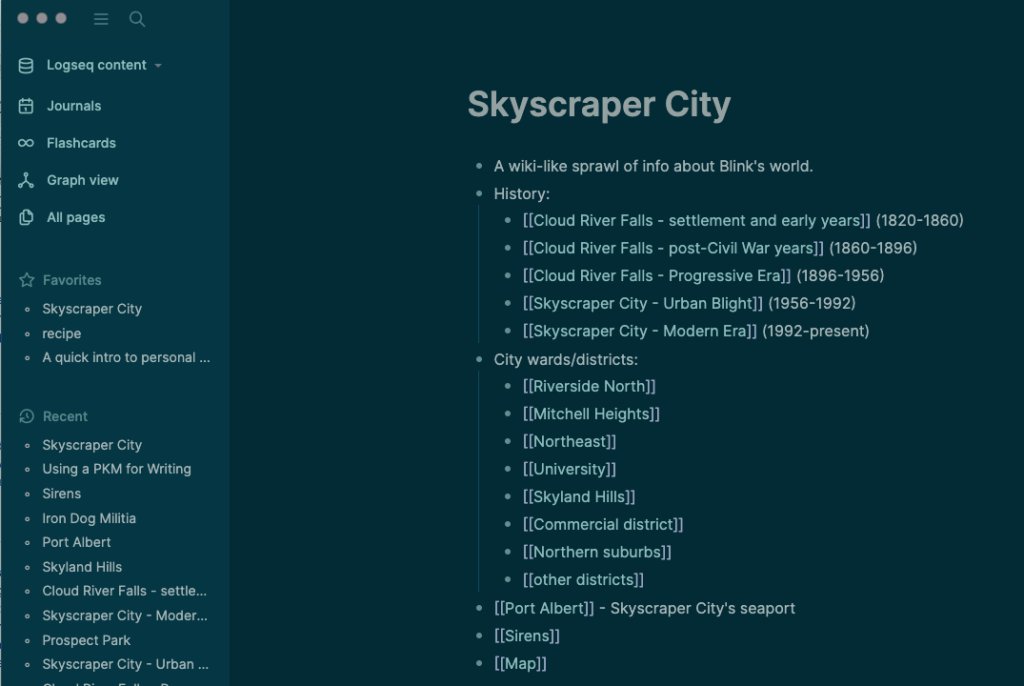The newest wave of productivity software is the Personal Knowledge Manager (PKM). PKMs have been around for a while—DevonThink on Macs is an early example that is still around—but they were complex and expensive, database-centric, and difficult to extract data from if you wanted to move to a new tool.
Newer PKMs can be more approachable (although most are incredibly complex if you do more than scratch the surface), and some have moved away from the database-centric paradigm. Some are databases, others are (at least for storage purposes) flat collections of files. Some are document-centric, others are outline-centric. Some store each note as a separate Markdown file, making it easier to access your data from outside the app. The new generation of PKMs use terms like digital garden or even second brain[1].
I should point out here, note-taking tools like Evernote, Joplin, Google Keep, or OneNote are not truly PKMs. I’ll get into the differences later, or perhaps the differences will become self-evident.
A highly incomplete survey of PKM tools
I’ve likely missed important entries, but these are the ones I’ve heard about enough to pay attention.
| Name | UI paradigm | Open source? | Markdown? | Journaling? | Other notes |
| DevonThink | Database | no | no | no | Old, but not decrepit |
| Logseq | Outliner | yes | yes | yes | Local storage |
| Obsidian | Document | no | yes | no | Local storage |
| Notion | Database | no | ? | no | Highly flexible, collaborative |
| Roam | Outliner | no | yes | yes | Cloud-based |
| Workflowy | Outliner | no | ? | no |
Pick a tool, based on what you think you need most (and don’t constrain yourself to this group of tools). Personally, I picked Logseq. It’s open-source, outliner-based, and I started using it as a journaling tool in the first place… then I found it had a lot more to offer. I will try to make the use cases as generic as possible, but I’m using Logseq to do all these things. Most others should work similarly, within their own features and constraints.
Capture thoughts and ideas
PKM apps that support journaling are great for recording thoughts, ideas, story prompts, and anything else you want to come back to some time in the future.
You can easily add those items without breaking your journaling flow. The trick is, consistent tagging. Anything you want to come back to later needs a tag. Many PKMs support either (or both) of #hashtags or [[Wiki-style links]]. These create backlinks to a pseudo-page that may actually exist, but is populated with data only in the PKM. You can add information, and other links, to a pseudo-page, which makes it a real page.
When you click a tag, the PKM shows you all the entries with that tag. Get your stuff (ideas) into your external memory, then you’ll be able to come back to them whenever you’re ready. Some PKMs let you create a list of “favorite” pages (I use it for pages I need to open often). In Logseq, right-click on a title to open a menu that (among other things) has an Add to Favorites choice.
This is one of the things that separate note-taking software from PKMs. You may be able to tag notes, but the PKMs build relationships between your notes, based on tagging.
Take control of your to-do list
David Allen, the author of Getting Things Done, is a big advocate for getting your action items out of your head and into external storage (paper or pixel). Logseq and most other PKMs have extensive task management functionality. There are two sets of flows in Logseq:
- TODO -> DOING -> DONE
- LATER -> NOW -> DONE
In addition, there’s a WAITING tag for items that you need from someone (or something) else, and DEADLINE and SCHEDULED tags for upcoming events. Logseq has a query mechanism that allows you to keep task items and scheduled events close at hand. Other apps likely have similar features. Whichever app you settle on, look up how to query task-management entries.
Keep your promotion info close at hand
I recently imported over 100 notes (web page captures, in many cases) from Evernote into Logseq. There were a lot of publishing- and promotion-related pages—review sites, ideas, tips, tools, on and on—but I never went back to them. As I brought the notes into Logseq, I did some extensive clean-up and made sure to tag each page according to its content.
Build a story bible
Personal wikis were made for story bibles. Start with an entry (top-level) page, add links, and get to work. Dive as deep as you like, but come up for air on occasion.

People and events can often be tied together. Sometimes, those relationships suggest new stories in your universe. The whole point is: you might be able to keep an entire universe, and its stories, consistent in your head. But if you get it out of your head, you have more capacity for new ideas to take root.
Flesh out new stories
If you’re a plotter, an outliner-based PKM is a great way to get going. Some PKMs support templates, so you can start from the skeleton of a particular story type and build from that. Just remember to tag the story page, so you can find it later! You can even add links to (or from) your story bible, if you need to come back to it later.
One Logseq user developed a template for scene or story writing. A copy of the template is available at Icedrive.
Personally, I use an outliner for… well, outlining, at least for fiction. I might export that outline to Scrivener, and flesh it out from there. But I don’t judge—for some reason, I find writing non-fiction (like this guest post) a smooth process in Logseq. If you want to write an entire story in your outliner (or write it in a non-outliner PKM tool), great!
Do you use a PKM? Which one? How does it make your writing life easier? Sound off in the comments!
[1] The idea of a “second brain” may be based on Getting Things Done, a methodology that pushes you to get your thoughts into external storage, so your subconscious can focus on other things.



